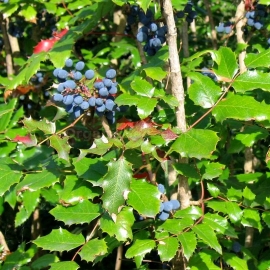






Organic Oregon Grape Seeds (Mahonia Aquifolium)
1.14 €
The Oregon grape is an attractive evergreen shrub that is native to the west coast of North America. Its fruits are blue berries that are borne in clusters and look somewhat like grapes. It is unrelated to the true grapes, however.
-
Organic Oregon Grape (Mahonia Aquifolium)
The Oregon grape is an attractive evergreen shrub that is native to the west coast of North America. Its fruits are blue berries that are borne in clusters and look somewhat like grapes. It is unrelated to the true grapes, however.
The berries are edible, but they taste sour rather than sweet, and they have large seeds. Like true grapes, though, they are sometimes used to make jam, jelly and wine.
Oregon grape is often grown as an ornamental plant, since its shiny, holly-like leaves, bright yellow flowers and blue berries are so beautiful. The plant is also valued because it attracts butterflies, bees and birds.
The inner bark and roots of Oregon grape contain a bright yellow chemical called berberine (or berberin). Berberine can act as a dye and is used to stain paper, silk, wool, leather and wood. It may have health benefits as well. It seems to fight at least some bacterial infections, and it may be helpful for other health disorders too.
How to Grow
Oregon Grape seeds have a deep dormancy within them, this requires a degree of patience to overcome and it is usually quite easy to get high levels of germination if the correct procedures are followed.
First prepare a free draining substrate into which the seeds are to be mixed, this can be a 50/50 mixture of compost and sharp sand, or perlite, vermiculite or even just pure sharp sand has worked well for me. The chosen substrate needs to be moist (but not wet), if you can squeeze water out of it with your hand it is too wet and your seeds may drown and die.
Mix the seeds into the substrate, making sure that their is enough volume of material to keep the seeds separated. Place the seed mixture into a clear plastic bag (freezer bags, especially zip-lock bags are very useful for this -provided a little gap is left in the seal for air exchange) If it is not a zip-lock type bag it needs to be loosely tied. Then write the date on the bag so that you know when the pre-treatment was started.
The seeds require a cold period to break the dormancy that is naturally found within them, this is easily achieved by placing the prepared bag of seeds and compost mix in the fridge (4 Celsius or 39F) for between 6 and 10 weeks. It is quite possible for the seeds to germinate in the bag at these temperatures when they are ready to do so, if they do, just remove them from the bag and carefully plant them up.
Seeds that are ready to germinate will have become plump and soft. For small quantities I tend to just leave the seeds in the fridge and remove the germinated ones as they arise and plant them up. I find that this way you can get the maximum number to germinate.
After a few months any remaining ungerminated seeds can have the cold pre-treatment process repeated again- several times if necessary. For larger quantities it is easiest to sow the seeds in a well prepared seedbed once the cold pre-treatment has finished and wait for the seeds to germinate. Seeds that are ready to germinate will be plump and soft, if they are not, the pre-treatment is not yet complete or has been ineffective due to incorrect temperatures or incorrect moisture content of the pre-treatment medium.
It has also been found that fluctuating pretreatment temperatures can give the best germination results and I have myself had excellent results by keeping the mixed seeds in a cold shed through the winter for the cold stage of their pretreatment and allowing the temperature to fluctuate naturally.
Do not expose newly sown seeds to high temperatures (above 25 Celsius) otherwise a secondary dormancy may be induced and the seeds will not germinate until they have been pretreated again. Germinated seeds can be planted in deep pots or plug trays in a good quality compost. Keep the seedlings well watered and weed free.
Growth in the first year is usually between 5 and 15cm and usually trouble free. Growth accelerates during the second year. Allow them to grow for 2 or 3 years before planting them in a permanent position.
